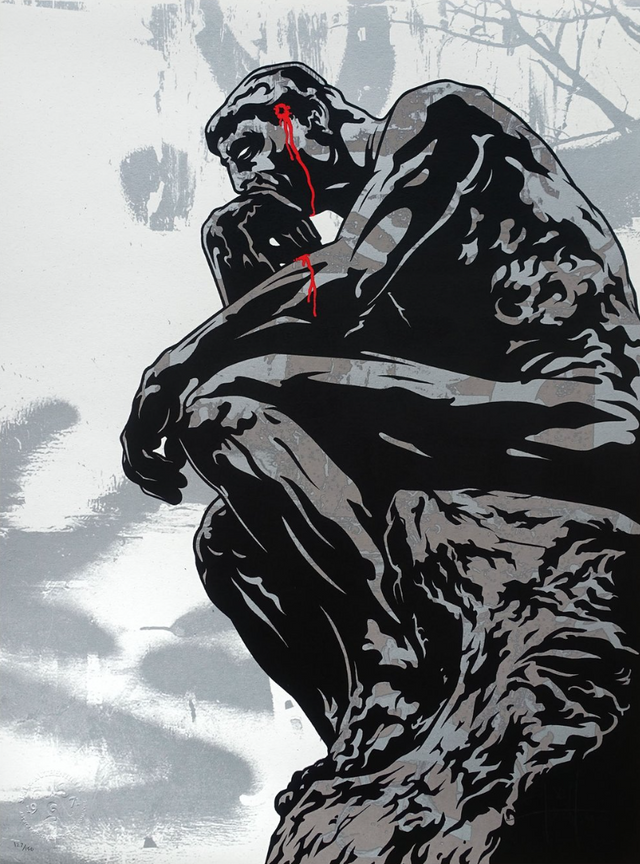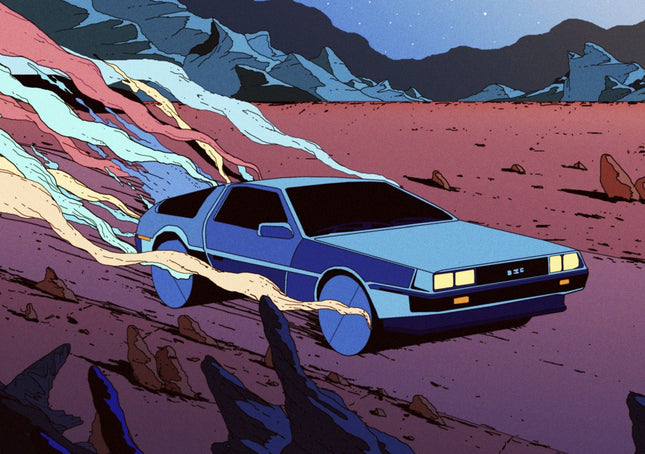
Silver
-

Kilian Eng (DW Design) Delorean Giclee Print by Kilian Eng (DW Design)
Delorean Artwork Giclee Limited Edition Print on Photo Rag Bright White Paper by Pop Culture Graffiti Artist Kilian Eng (DW Design). 2013 Signed & Numbered Limited Edition Print on paper (Photo Rag Bright White 310 gsm) 17 H x 24 W inch. Swedish artist Kilian Eng (DW Design) has a unique style and visual language that is sometimes described as retro-futuristic. Eng illustrates and animates images and art prints that feel dreamlike and evoke curiosity, like this Delorean image, obviously inspired by the Back to the Future movies. "I’m very interested in creating environments in my work. I’m fascinated by architecture - ancient, futuristic, fantastic - so I often incorporate buildings or structures. The characters that inhabit the pictures are dropped in these unexpected surroundings." -Kilian Eng Revving Through Time: Kilian Eng's Retro-Futuristic Delorean In the dynamic world of pop culture art, few images are as evocative of the spirit of adventure and the aesthetics of retro-futurism as the Delorean car. The iconic vehicle, etched into the collective memory of the 80s and beyond, finds new life in the work of Swedish artist Kilian Eng. Known professionally as DW Design, Eng's limited edition Giclee print on Photo Rag Bright White Paper breathes a unique blend of nostalgia and futuristic fantasy into the subject. Kilian Eng, born in Sweden, stands out for his distinctive style that combines elements of street pop art and graffiti artwork, though his work leans more towards illustration with a heavy influence from the fantastical and science fiction elements. His Delorean artwork, a signed and numbered limited edition print from 2013, exemplifies this style perfectly. Measuring 17 by 24 inches and printed on Photo Rag Bright White 310 gsm paper, the piece showcases Eng's commitment to quality and his passion for creating immersive environments within his works. Dreamlike Visions: The Architecture of Time in Eng's Work Eng has a well-documented fascination with architecture, which serves as the structural backbone for many of his pieces. His Delorean art print is no exception. The vehicle is set against a dreamlike backdrop that merges ancient and futuristic sensibilities, a hallmark of Eng's work. This setting is not just a passive background; it's an integral part of the narrative that Eng crafts through his art. The Delorean, synonymous with time travel in the 'Back to the Future' franchise, is depicted amidst a landscape that feels both familiar and otherworldly, embodying the convergence of past, present, and future. The artist's inclination to place characters — or in this case, iconic cars — within unexpected surroundings aligns with the ethos of graffiti artwork, where the surprise element and the boldness of the presentation are key. In Eng's Delorean print, the car takes center stage, its familiar form a stark contrast to the alien landscape, which could be a scene straight out of a distant planet or parallel universe. Eng's Visual Language: A Portal to Retro-Futuristic Exploration Kilian Eng's artistic language speaks of curiosity and exploration, two themes deeply embedded in the concept of the Delorean. The car, a symbol of technological innovation and the wild possibilities of time travel, is a fitting subject for Eng's exploration of space and environment. The choice of the Delorean, particularly within the context of a limited edition print, also speaks to the artist's understanding of pop culture's ephemeral yet impactful nature. The print itself, with its meticulous attention to detail and color, mirrors the quality one would expect from a graffiti artwork masterpiece. While Eng's work is not painted on a wall or a train car, it carries the same spirit of street pop art — it's accessible, it's for the people, and it carries a message. The message here is one of wonder, the same kind of wonder that street art aims to evoke in passersby. Kilian Eng's Delorean is not just a print; it's a window into the kind of retro-futuristic world that only exists in the collective dreams of those who grew up with the 'Back to the Future' movies as a touchstone. It's a testament to the enduring appeal of the Delorean as an icon, not just of a movie franchise, but of an era where cars were more than just vehicles — they were the keys to adventure, the vessels for voyages of the imagination. Eng's print captures this spirit in a way that both honors and transcends the original inspiration, making it a significant piece in the realm of street pop art and graffiti artwork.
$352.00


